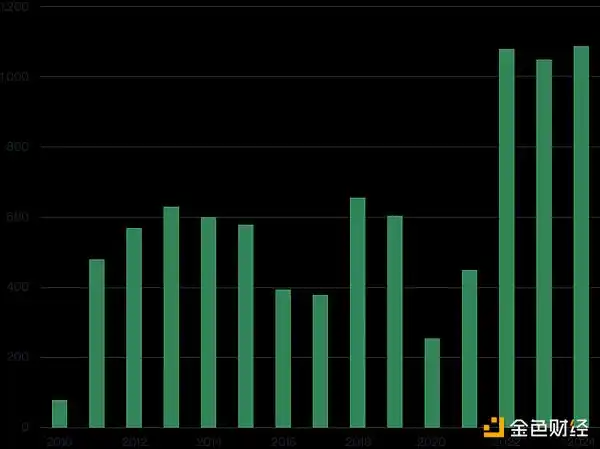Bitwise CIO: Why Has Gold Outperformed Bitcoin?
Original Title: Gold's Rise Bodes Well for Bitcoin
Author: Matt Hougan, Chief Investment Officer at Bitwise
Translated by: Jinse Finance
Currently, there are two core questions about bitcoin in the crypto market:
1. Why has gold outperformed bitcoin so significantly?
2. Given the massive purchases by ETFs and corporations, why does bitcoin's price remain stagnant?
In fact, if we can carefully answer the first question, the answer to the second will also emerge—and this answer paints a highly bullish picture for bitcoin's future.
Next, I will analyze in detail.
Question 1: Why has gold outperformed bitcoin so significantly?
Although gold prices have recently pulled back, they have surged rapidly this year, with a 57% increase in 2025, heading toward the second-best annual performance in history in USD terms. Meanwhile, bitcoin has stagnated near the $110,000 mark, with prices roughly flat since May.
This has frustrated investors who view bitcoin as "digital gold," but there is actually a simple explanation: the difference stems from the actions of central banks.
Since the U.S. froze Russia's holdings of U.S. Treasuries after Russia invaded Ukraine, central banks around the world have started to significantly increase their gold reserves. According to data from Metals Focus, central bank gold purchases have nearly doubled since the outbreak of the Russia-Ukraine war, rising from about 467 tons per year to about 1,000 tons now, which is about twice the estimated purchase volume of gold ETPs (exchange-traded products).
Bitcoin, however, does not enjoy this treatment. Although some central banks are researching bitcoin, none have actually bought it yet. Therefore, if central banks are the main driver behind the recent surge in gold prices, it is logical that bitcoin has not followed suit.
This view is not new. Institutions and individuals such as Morgan Stanley, JPMorgan, and Mohamed El-Erian have all pointed out that central bank gold purchases are the key driving force behind the surge in gold prices.
Question 2: Why does bitcoin's price remain stagnant despite massive ETF and corporate purchases?
How is this related to the second question?
The answer is: very closely related.
The biggest mystery in the bitcoin market is why, despite massive buying by ETFs and corporations, the price has remained relatively stable. Since the launch of bitcoin ETFs in January 2024, ETFs and corporations have purchased a total of 1.39 million bitcoins, while the new supply from the bitcoin network during the same period is less than a quarter of that amount. Although bitcoin's price has risen 135% since then—a strong performance—many still wonder: shouldn't it have risen even higher?
I have had the same question: who is selling so much bitcoin? What is preventing it from breaking through the $200,000 mark?
The current surge in gold prices provides the answer.
See the table below, which shows annual gold purchases by central banks from 2010 to 2024. In 2021, central banks bought 467 tons of gold, which jumped to 1,080 tons in 2022 and has remained at this high level since then (forecasts show that demand in 2025 will be slightly lower than in 2024).
Central bank gold purchases from 2010 to 2024 (unit: tons):

Source: World Gold Council
In short, although central bank gold purchases are an important catalyst for this year's gold price surge, these purchases did not start this year—they began in 2022.
This also provides an answer for bitcoin's current situation.
When central bank gold purchases began to increase sharply in 2022, gold's price rose slowly: the average price in 2022 was $1,800, rising to $1,941 in 2023 (an increase of only 8%), and to $2,386 in 2024 (a 23% increase). It was not until this year that gold prices experienced an explosive surge, rising nearly 60% to about $4,200.
In other words: central banks started buying gold in 2022, but gold prices only saw a parabolic surge in 2025.
I think the logic is clear: in any market, there are some price-sensitive investors—these investors tend to act when prices move up or down by 10%-15%. When central banks began buying large amounts of gold in 2022 and pushed prices up, these investors took the opportunity to sell their gold as demand rose. But eventually, this selling pressure is exhausted, and then prices rise sharply.
I suspect bitcoin is currently in a similar stage.
As mentioned earlier, since ETFs and corporations began buying heavily in 2024, bitcoin's price has already increased 2.3 times. During this period, price-sensitive holders have seized the opportunity to sell and take profits.
But as the gold price example shows, one day this selling pressure will be exhausted. As long as the combined buying by ETFs and corporations continues (which I believe is highly likely), bitcoin will have its own "2025 gold moment."
My advice: be patient.
Don't envy the explosive rise in gold prices; instead, see it as a sign—it may be showing us the future path of bitcoin.
Original link
Disclaimer: The content of this article solely reflects the author's opinion and does not represent the platform in any capacity. This article is not intended to serve as a reference for making investment decisions.
You may also like
Must Public Chains Embrace the Meme Trend?
The experience of Solana teaches us that "governments" should not direct the development of "enterprises."

Space Review|JST Buyback and Burn Plan Officially Launched, Ushering in a New Chapter for TRON DeFi Value
The large-scale JST buyback and burn plan has been launched, injecting protocol net income into a deflationary model to build a sustainable "value flywheel."

Virtuals Robotics: Why Did We Enter the Field of Embodied Intelligence?
Digital intelligence acquires physical entities, integrating thought and action in the field of robotics.

The EU imposes sanctions on the stablecoin A7A5 pegged to the Russian ruble.
